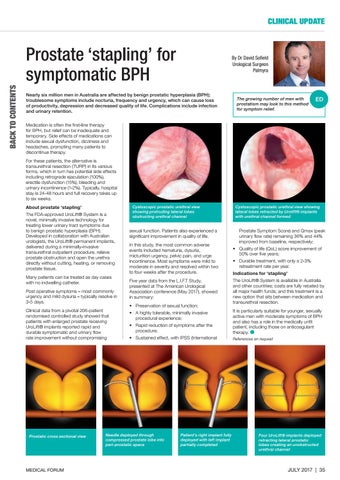CLINICAL UPDATE
Prostate ‘stapling’ for symptomatic BPH
By Dr David Sofield Urological Surgeon Palmyra
Nearly six million men in Australia are affected by benign prostatic hyperplasia (BPH); troublesome symptoms include nocturia, frequency and urgency, which can cause loss of productivity, depression and decreased quality of life. Complications include infection and urinary retention.
The growing number of men with prostatism may look to this method for symptom relief.
ED
Medication is often the first-line therapy for BPH, but relief can be inadequate and temporary. Side effects of medications can include sexual dysfunction, dizziness and headaches, prompting many patients to discontinue therapy. For these patients, the alternative is transurethral resection (TURP) in its various forms, which in turn has potential side effects including retrograde ejaculation (100%), erectile dysfunction (15%), bleeding and urinary incontinence (1-2%). Typically, hospital stay is 24-48 hours and full recovery takes up to six weeks. About prostate ‘stapling’ The FDA-approved UroLift® System is a novel, minimally invasive technology for treating lower urinary tract symptoms due to benign prostatic hyperplasia (BPH). Developed in collaboration with Australian urologists, the UroLift® permanent implants, delivered during a minimally-invasive transurethral outpatient procedure, relieve prostate obstruction and open the urethra directly without cutting, heating, or removing prostate tissue. Many patients can be treated as day cases with no indwelling catheter. Post operative symptoms – most commonly urgency and mild dysuria – typically resolve in 3-5 days. Clinical data from a pivotal 206-patient randomised controlled study showed that patients with enlarged prostate receiving UroLift® implants reported rapid and durable symptomatic and urinary flow rate improvement without compromising
Prostatic cross sectional view
MEDICAL FORUM
Cystoscopic prostatic urethral view showing protruding lateral lobes obstructing urethral channel
sexual function. Patients also experienced a significant improvement in quality of life. In this study, the most common adverse events included hematuria, dysuria, micturition urgency, pelvic pain, and urge incontinence. Most symptoms were mild to moderate in severity and resolved within two to four weeks after the procedure. Five year data from the L.I.F.T Study, presented at The American Urological Association conference (May 2017), showed in summary: • Preservation of sexual function; • A highly tolerable, minimally invasive procedural experience; • Rapid reduction of symptoms after the procedure; • Sustained effect, with IPSS (International
Needle deployed through compressed prostate lobe into peri-prostatic space
Patient’s right implant fully deployed with left implant partially completed
Cystoscopic prostatic urethral view showing lateral lobes retracted by Urolift® implants with urethral channel formed
Prostate Symptom Score) and Qmax (peak urinary flow rate) remaining 36% and 44% improved from baseline, respectively; • Quality of life (QoL) score improvement of 50% over five years; • Durable treatment, with only a 2-3% retreatment rate per year. Indications for ‘stapling’ The UroLift® System is available in Australia and other countries; costs are fully rebated by all major health funds; and this treatment is a new option that sits between medication and transurethral resection. It is particularly suitable for younger, sexually active men with moderate symptoms of BPH and also has a role in the medically unfit patient, including those on anticoagulant therapy. References on request
Four UroLift® implants deployed retracting lateral prostatic lobes creating an unobstructed urethral channel
JULY 2017 | 35
